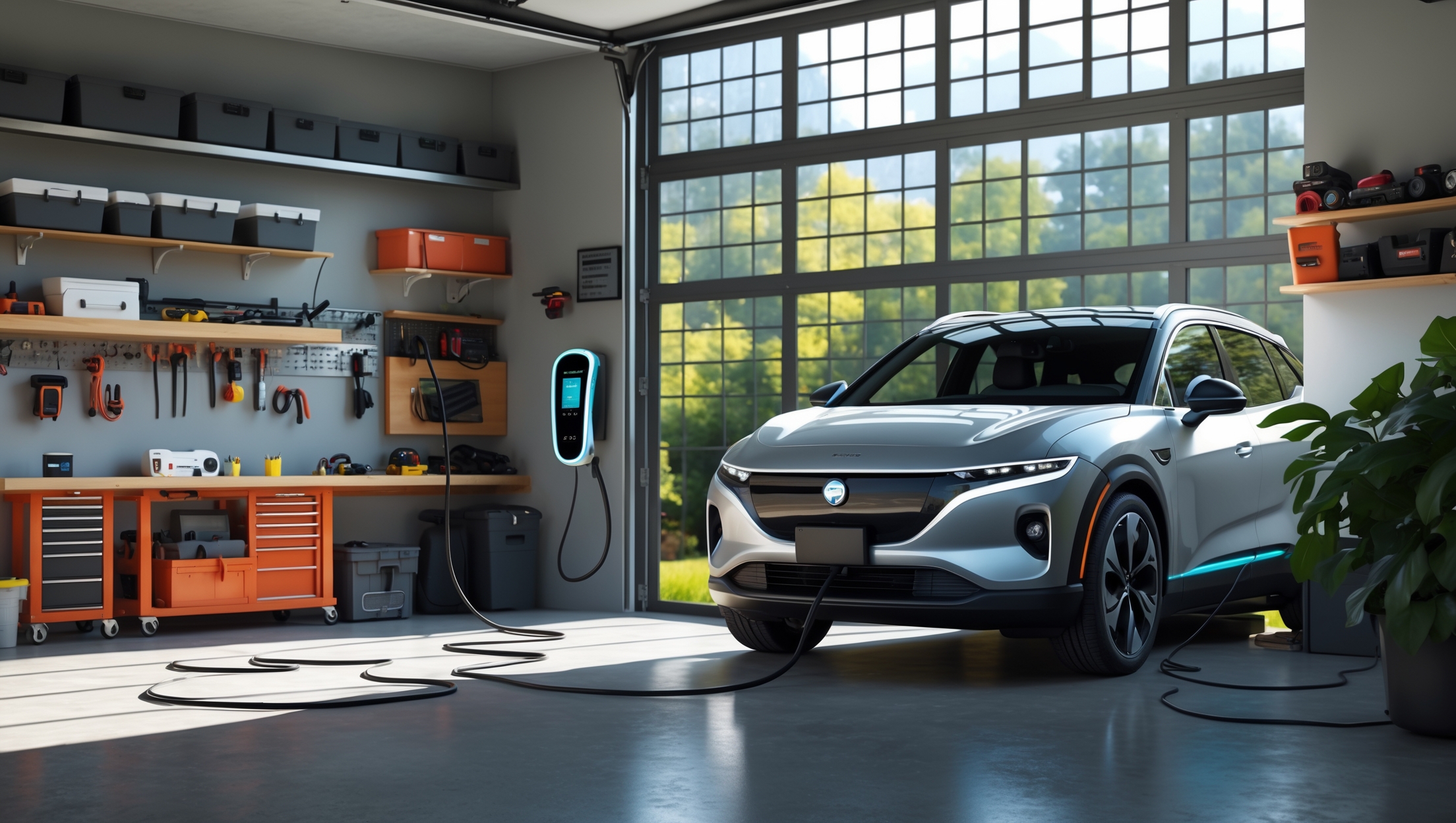Introduction: Why Home EV Charging Matters in Sustainable Living
Electric vehicles (EVs) have become a cornerstone of sustainable living, offering an effective way to reduce carbon emissions and reliance on fossil fuels. However, the convenience and efficiency of owning an EV are closely tied to your ability to charge it at home. A dedicated home EV charging station not only saves time and money but also maximizes your vehicle’s environmental benefits by allowing you to use green energy sources. Building your own charging setup requires careful planning and the right tools—both to ensure safety and to future-proof your investment. This guide provides a comprehensive, step-by-step overview of the essential tools and equipment needed to build a reliable, code-compliant home EV charging station. Whether you’re a hands-on DIY enthusiast or an eco-conscious homeowner preparing to work with a licensed electrician, understanding the process and gear involved will help you achieve a safe, efficient, and sustainable result. Let’s explore what it takes to set up a charging station that complements your green lifestyle.
Understanding EV Charging Levels and Home Compatibility
Before assembling tools and equipment, it’s crucial to understand the different types of EV charging and how each fits into a residential setting.
Level 1 Charging: Basics and Limitations
- Power Source: Standard 120V household outlet.
- Charging Speed: 2–5 miles of range per hour.
- Equipment Needs: Minimal; often just the portable cord set included with most EVs.
- Suitability: Best for plug-in hybrids or low-mileage daily driving.
Level 2 Charging: The Homeowner’s Sweet Spot
- Power Source: 240V dedicated circuit.
- Charging Speed: 10–60 miles of range per hour, depending on vehicle and charger specs.
- Equipment Needs: Wall-mounted charging unit, upgraded electrical wiring, dedicated breakers.
- Suitability: Ideal for most EV owners and future-proof for upcoming models.
Level 3 Charging: Not for Homes
- Power Source: 400V–900V DC, industrial-grade and not suitable for residential use.
- Charging Speed: 100+ miles of range per 30 minutes.
- Suitability: Commercial installations only.
Planning Your Home EV Charging Station
Proper planning ensures your installation is safe, efficient, and meets your needs as your EV usage grows. Here’s how to prepare.
Assess Your Electrical Panel and Capacity
- Check your main panel’s amperage rating (typically 100A, 150A, or 200A in modern homes).
- Determine available capacity by calculating the sum of existing loads and comparing to the main breaker rating.
- Consult a licensed electrician for a load calculation if you’re unsure.
Choose the Ideal Location
- Prefer locations close to the parking area to minimize wiring length and cost.
- Ensure the spot is protected from the elements, or choose a weatherproof charging unit.
- Allow room for cable management and ventilation.
Obtain Required Permits
- Most municipalities require an electrical permit for Level 2 charger installation.
- Inspections ensure compliance with local codes and safety standards.
Essential Tools for Home EV Charging Station Installation
Whether you’re doing the installation yourself or preparing for a contractor, having the right tools on hand streamlines the process and ensures a safe outcome. Below is a detailed breakdown of what you’ll need.
Basic Hand Tools
- Voltage Tester/Multimeter: For confirming live wires and ensuring circuits are de-energized before work starts.
- Screwdrivers (Flathead & Phillips): For mounting brackets, removing panel covers, and connecting wires.
- Wire Strippers: For preparing electrical wires for connections.
- Needle-nose and Lineman’s Pliers: For gripping, twisting, and connecting wires.
- Adjustable Wrench: For tightening nuts on conduit fittings and mounting hardware.
- Tape Measure: For accurate placement and routing of conduit and charger mount.
- Hammer Drill/Impact Driver: For drilling into masonry or concrete (if mounting on a garage wall).
- Bubble Level: Ensures your charging unit is mounted straight and secure.
Electrical Tools
- Conduit Bender: For routing metal or PVC conduit neatly along walls or ceilings.
- Fish Tape: To guide wiring through conduit runs.
- Wire Cutters: For trimming wire lengths cleanly.
- Circuit Breaker Finder: Helps identify the correct breaker in your panel before shutting off power.
- GFCI Outlet Tester: Confirms proper grounding and safety of new outlets.
Safety Gear
- Insulated Gloves: Protects against accidental electric shock.
- Safety Glasses: Shields eyes from metal shavings or debris during drilling.
- Dust Mask: Useful if cutting drywall or masonry.
- Work Boots: Non-slip soles and electrical hazard rating recommended.
Specialized Equipment
- Stud Finder: For locating wall studs to securely mount charging hardware.
- Hole Saw Kit: Makes clean holes for conduit or cable runs through walls.
- Label Maker or Electrical Markers: For clear circuit and wire identification—crucial for future maintenance.
- Torque Wrench: Ensures all electrical connections are tightened to manufacturer specifications, reducing risk of overheating.
Choosing the Right Charging Station Hardware
The selection of the charging unit itself is critical for performance, safety, and long-term sustainability.
Key Features to Consider
- Amperage Rating: Most home Level 2 chargers offer 16A, 32A, or 40A. Higher amperage enables faster charging but requires heavier-gauge wiring and a compatible circuit breaker.
- Cable Length: Choose a cable long enough to reach your EV’s charge port comfortably—typically 16–25 feet.
- Smart Connectivity: Wi-Fi/Bluetooth for monitoring, scheduling, and integrating with solar or home energy management systems.
- Weatherproofing: NEMA 4 or better enclosures for outdoor or exposed installations.
- Plug vs. Hardwired: Plug-in units offer flexibility and portability, while hardwired units are more permanent but may be preferred where local codes require it.
Top Brands and Models
- ChargePoint Home Flex: Adjustable amperage, Wi-Fi connectivity, robust app support.
- JuiceBox 40: Flexible installation, smart scheduling, energy usage tracking.
- Grizzl-E Classic: Rugged, weatherproof, straightforward operation—ideal for harsh climates.
Step-by-Step Installation Process
This high-level overview outlines the key steps and where each tool comes into play. For most homeowners, the physical installation should be handled by a licensed electrician due to code requirements and safety risks, but understanding the process helps you plan and oversee the project.
1. Turn Off Power and Verify
- Use the circuit breaker finder to identify and switch off the correct breaker.
- Double-check with a voltage tester or multimeter to ensure no power is present at the work location.
2. Install the Dedicated Circuit
- Route appropriately sized wire (typically 6 or 8 AWG) from your main panel to the charging station location via conduit.
- Use the conduit bender, fish tape, and wire strippers as needed.
- Install a new double-pole breaker rated for the charging station’s amperage.
- Label the new circuit clearly inside the panel.
3. Mount the Charger
- Use a stud finder to locate solid mounting points.
- Mark positions using a tape measure and bubble level.
- Drill pilot holes and use appropriate anchors if mounting on drywall or masonry.
- Secure the wall bracket and charger using screwdrivers or an impact driver.
4. Make Electrical Connections
- Connect wires from the circuit to the charger per manufacturer instructions.
- Use a torque wrench to tighten terminals to specified values.
- Ensure all connections are neat, secure, and properly insulated.
5. Final Inspection and Testing
- Restore power at the breaker panel.
- Use a GFCI tester and the charger’s built-in diagnostics to confirm functionality.
- Schedule your municipal inspection as required.
Maintenance Tools and Practices for Ongoing Safety
Once installed, regular maintenance is essential for safety and optimal performance. Here’s the toolkit and routine you’ll need.
Visual Inspection Tools
- Flashlight or Inspection Lamp: For checking behind the station or in poorly lit areas.
- Small Mirror: Allows you to view hidden or awkward angles behind the charger.
Routine Maintenance Checklist
- Check charging cable for wear, cracks, or exposed wires.
- Inspect the mounting hardware for signs of corrosion or loosening.
- Test GFCI functionality at least quarterly.
- Wipe down the unit and cable with a damp cloth to remove dust and debris.
- Keep area around the station free of obstructions and flammable materials.
Annual Professional Checkup
- Have a licensed electrician inspect the connections, breaker, and wiring for any signs of overheating or wear.
- Update firmware on smart chargers as recommended by the manufacturer.
Future-Proofing Your Home EV Charging Station
EV technology is evolving rapidly. Planning ahead keeps your investment relevant and efficient as your needs change.
Considerations for Upgrades
- Install Higher-Gauge Wiring: Even if your current EV only needs 16A or 24A, using 40A-capable wiring now can save major labor and expense if you upgrade vehicles or chargers in the future.
- Smart Home Integration: Choose a charger compatible with your home automation or energy management system.
- Solar Readiness: If you have or plan to install solar panels, select a charger that can coordinate with solar production for maximum green energy use.
- Cable Management: Install a retractable reel or wall hooks for neat, accessible storage.
Troubleshooting Tools and Tips
On occasion, you may encounter issues such as slower charging, connectivity problems, or tripped breakers. Here are the tools and checks that will help you resolve most problems quickly.
- Multimeter: To check voltage levels at the outlet and charger terminals.
- Wi-Fi Signal Tester: For diagnosing smart charger connectivity issues.
- Thermal Camera: Advanced but useful for detecting hot spots at electrical connections, preventing failures.
- Manufacturer’s App or Diagnostic Tool: Most smart chargers offer built-in diagnostics accessible from your phone.
Recycling and Disposal: Sustainable Equipment Choices
Sustainability doesn’t stop at installation. When upgrading parts or replacing old chargers, responsible disposal is a must.
- Recycle old chargers and cables at certified e-waste facilities.
- Choose components made with recycled materials when available.
- Donate functioning but outdated units to local non-profits or community organizations.
Conclusion: Empowering Sustainable Mobility at Home
Building a home EV charging station is more than a home improvement project—it’s a meaningful step towards a cleaner, smarter, and more sustainable way of living. With the right tools and equipment, you can ensure your installation is safe, efficient, and ready for the future. By understanding each phase—from assessing your home’s electrical capacity, gathering the appropriate tools, and selecting robust charging hardware, to regular maintenance and troubleshooting—you’re not just making it easier to own an electric vehicle, you’re advancing the transition to a low-carbon lifestyle. Remember, while DIY can be rewarding, electrical work should be approached with caution and in compliance with all local codes and safety practices. Partnering with a qualified electrician ensures your investment is protected and your family is safe. As technologies evolve, keeping your charging setup up-to-date and well-maintained will maximize both its value and its environmental impact. By equipping yourself with knowledge and the right gear, you’re paving the way for a greener tomorrow, one charge at a time.





With all the different tools and equipment listed for building a code-compliant charging setup, is there a recommended starter toolkit for someone who has never done electrical work before?
For beginners, a basic toolkit should include insulated screwdrivers, wire strippers, a voltage tester, a tape measure, and safety gloves. If you’re completely new to electrical work, it’s best to avoid high-voltage tasks yourself—consider using these tools for simple preparations and let a licensed electrician handle the actual installation for safety and code compliance.
For someone considering building a Level 2 charging station at home as you described, are there any important local electrical codes or permitting requirements that might catch a DIYer off guard during installation?
Yes, local electrical codes and permitting can be tricky for DIYers. Many areas require a permit before installing a Level 2 charger, and an inspection afterward. You’ll also need a dedicated 240V circuit, which must be installed to code—often by a licensed electrician. Grounding, wire gauge, and breaker size are common code concerns. It’s always smart to check with your local building department before starting to avoid issues later.